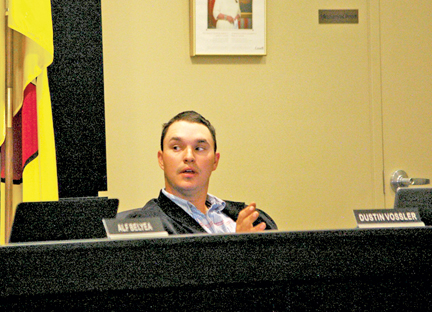Current Temperature
-0.1°C
Farmers excited to put 2018 in the rearview
Posted on October 16, 2018 by 40 Mile Commentator Ag service board chairman Dustin Vossler
Ag service board chairman Dustin VosslerBy Scott Schmidt
Alberta Newspaper Group
With normal seasonal temperatures finally arriving this week, most southeastern Albertans will be enjoying a reprieve from this year’s early chill.
For many of the region’s farmers however, the warm-up just might be a lifesaver.
“I can tell you, there’s not going to be a farmer around here that’s not going to be happy when this year is over,” said Agricultural Service Board chair Dustin Vossler. “When you have cool days like this, you get zero drying out of it, and when you get those rain showers over five days, it just adds insult to injury.”
September is an extremely important month for harvesting, and Vossler says much of the month was lost due to the cold. And while a cool finish to the summer isn’t unheard of, this year also came with a late start thanks to a seemingly never-ending winter. That’s a tough combination to endure, and many farmers in the region were caught off guard by it.
“It definitely set everybody back, myself included,” Vossler said. “Most of the guys around here haven’t turned a wheel in almost four weeks now. And there are a lot of acres left on the ground yet.”
He says at least 25 per cent of crops are still in the ground for farmers in the Seven Persons area, and that number grows for many as you head north. Most crops were ready to come off when the cold snap hit, but without an extended spike to the mercury, producers are forced to sit and wait.
“Most everything was done and ready, it’s just a matter of getting the weather to get it off,” Vossler says. “(But) unless we get some good heat, it’s just not going to happen.”
He says crops like canola and flax can handle the drop in temperature, but for farmers growing grains like wheat, any left standing at this point will start to sprout and can take the grade from a No. 1 and turn it into nothing more than feed.
Most predictions are calling for a mild autumn, and after a nonexistent start to that, the warmer weather has arrived. Regional forecasts are calling for an extended period of not only mid-teen temperatures during the day, but also several days without frost.
“It certainly should help,” Vossler said. “A few days in a row without frosting at night will be a big help in settling a few guys’ nerves. Everybody is getting a little antsy around here.”
Steve Wikkerink, Forty Mile Reeve and an irrigation farmer in the county’s northern region, is also seeing abnormalities from this year’s weather. While the lack of rain in the summer can be a good thing for irrigation farmers, the cooler temperatures this fall are taking their toll.
“We have 50 per cent of our beans still out, and about 85 per cent of our beets,” he says. The late harvest for sugar beets is normal, but the overlap with dry beans is not. “From what we’ve been hearing about bean plants around Bow Island, they’re only sitting at about 50 per cent done.
“That affects sales; it could potentially affect how many employees they keep over the winter, so they’re really hoping for (good weather.) I think two weeks would (be enough) to get the beans done.”
The forecast certainly favours the needs of local farmers over the next couple of weeks, but after a few years of roller-coaster climate, some things need to fall in place soon to avoid continued struggles.
“We’re going to need a good snowfall this winter, and some precipitation through May, June, July, and if it could keep raining a little bit after, that would be great, too,” Vossler said. “We don’t need a lot of rain, but we need the appropriately-timed rain.
“A typical Alberta summer would be great. We haven’t seen one in a while — it’s gone from one extreme to the other. If you think back three years ago, it was so wet nobody could do anything.”
Leave a Reply
You must be logged in to post a comment.

